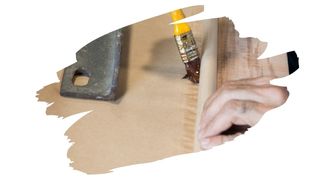Not all wood finishes pair well with food prepping surfaces.
That’s because a number of popular wood finishes are too toxic to risk them coming into direct contact with food. But, is lacquer one such type of finish?
In this post, you will learn what really makes a wood finish food safe (hint: it’s not enough for it to simply be dry to the touch). You will also find out the difference between a dry lacquer and a cured lacquer (and why this matters for your health).
And we reveal whether or not a lacquer finish is suitable for a cutting board surface.

This post may contain affiliate links to products that we receive a commission for (at no additional cost to you). Learn more here.
Which Wood Finishes Are Food Safe?
Generally, wood finishes made from edible ingredients are perfectly food safe.
For example, raw Linseed oil is a drying oil that’s extracted from crushed flaxseed. This finish is food safe in its purest form.
Related Post: Is Linseed Oil Food Safe Enough To Use On A Cutting Board?
Also, food grade mineral oil, (a non-drying oil used to seal cutting boards), is made from highly refined petroleum.
This food safe finish is non-toxic. And pure food grade mineral oil is even fit for human consumption (although it is mostly used as a laxative).
What About Lacquer? What Is Lacquer Made Of?
The answer to this depends on the lacquer product. You see, lacquer is the name given to any wood finish made from a blend of solvents and resins.
For example, liquid shellac is a lacquer. Made from the resinous by-product of lac bugs, shellac in its purest flake form is non-toxic. But, before it can be used as a finish, shellac needs to be thinned out using high proof denatured alcohol. And the inclusion of denatured alcohol makes shellac poisonous in liquid form.
However, while shellac is a type of lacquer, not all lacquers are shellac.
For example, Acrylic Lacquer and Nitro Lacquer, are two popular solvent-based lacquers. These lacquers contain toxic additives such as Acetone, N-Butyl, and Toluene.
Related Post: Don’t Put Nitro Lacquer Over That Polyurethane Finish [Here’s Why]
But Is A Dried Lacquer Safe?
Well, another one of the dangers of solvent-based lacquers, (other than the risk of consuming them), is their VOC content.
VOC’s (volatile organic compounds) are the gasses found in the lung-searing fumes released from wood finishes. And VOC’s are most concentrated in solvent-based chemical products.
Plus, whether in liquid form or aerosol spray, lacquer finishes release a high level of VOC’s into the air. This process is referred to as ‘off-gassing’.
Now, those VOC’s can cause severe breathing issues if inhaled. Which is why it’s important to wear an air-filtering respirator mask when applying lacquer finishes.
Still, even if a lacquer finishing coat feels dry to the touch, that doesn’t mean those VOC’s have stopped releasing. That is because a dry lacquer isn’t a wholly cured lacquer.
Difference Between Dry And Cured Lacquer Finishes
A dry lacquer has gone through an evaporation process. Meaning that it has turned from a liquid into a solid film.
But curing is a chemical process. Which means that the chemical bonds of the finish have undergone a change. This change turns lacquer into a hard resin coat.
Now, wood sealing lacquers can take as little as 2 hours to dry on the surface. Yet, lacquer can continue off-gassing for over 30 days. This is because the finish continues its curing process underneath that surface film.
And while those fumes continue to release into the air, a dry lacquer is not ‘food safe’.
Related Post: Can You Put Lacquer Over A Wax Finish? (Best Practice Revealed)
So Is A Lacquer Finish Ever Safe?
A lacquer finish is safe only once it has finished drying and curing. Both processes need to complete their run, before that surface is ready for use.
However, for a lacquer finish to be food safe (i.e. safe enough for direct or indirect contact with food), it needs something more. A truly food safe finish is one that only contains food safe resins and coatings.
The US FDA (The United States Food And Drug Administration) have curated an industry standard list of food safe resins and coatings. Lacquer products that meet this standard, can be deemed as food safe. And only after they’ve dried and cured, of course.
And if your lacquer product contains ingredients that are not on this list, then err on the side of caution…write it off as not food-safe.
Can You Put Lacquer On A Cutting Board?
No, you can’t…and that’s even if you were sure that lacquer finish was food-safe. That’s because lacquer is not suitable for a cutting board for two key reasons:
A). Lacquer Is A Very Brittle Finish
Chopping blocks get chopped a lot… it’s in the name. And lacquer finishes, (whether it be shellac-based, nitro, or acrylic), are easily scratched.
So, Brittle finish + Chopping kitchen utensils = Bad combination.
B). Lacquer Isn’t A Waterproof Finish
Lacquer can handle the odd brief water spill. But, all of those regular soapy washes will damage a lacquer finish.
And harsh soaps and cleaners can contain chemicals capable of dissolving lacquer finishes too.
To Wrap Up, Here Are The 3 Key Takeaways From This Post…
- 1). Lacquer finishes can release solvent fumes long after they’ve dried. Lacquers may take a few hours to dry, but they can take weeks to fully cure.
- 2). A truly food safe wood finish is one that only contains FDA approved resins and coatings.
- 3). Lacquer isn’t a good cutting board wood finish. Lacquer is too easily scratched and water-damaged, to handle life atop a chopping block.
References:
Wang, Qifan, et al. “Effect of lacquer decoration on VOCs and odor release from P. neurantha (Hemsl.) Gamble.” Scientific reports 10.1 (2020): 1-10.

